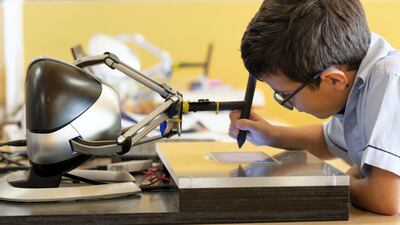Abu Dhabi pupils are the first children worldwide to trial a technology that teaches handwriting using a robotic arm.
Two classes at Cranleigh Abu Dhabi – an FS2 and a Year Two class – are involved in the 11-week trial.
The technology was developed by Mohamad Eid, assistant professor of electrical and computer engineering at NYU Abu Dhabi, who initially used the device to teach adults Arabic handwriting, with good results.
Academic studies in various countries have charted the decline of handwriting ability, typically linked to the rise of social media, instant messaging and tablet devices.
"I was attending conferences and events organised by the Department of Education and Knowledge and other places and I got very positive interaction from children attending those events," Mr Eid said.
“I thought maybe it is time to try this out in a formal study with children.”
So he reached out to Cranleigh Abu Dhabi, which was happy to oblige.
Tania Moonesinghe, head of Pre-Prep at Cranleigh Abu Dhabi, worked with Mr Eid at the university to set it up.
“We spent a lot of time [speaking about] how we teach it, because his initial reaction was to use capital letters to approach it from A,B,C,” she said.
“So part of it was an education on how we teach using lower script and how we teach from a phonetic point of view.”
Teaching handwriting is usually a fairly long drawn-out process, which begins in FS1, during a pupil’s first year of school, she added.
Children are encouraged to use tweezers to pick things up, trace and draw letters in the sand to build their finger muscles.
“And actually we find that children’s muscle control is actually not as good as it was a few years ago, I think because they don’t do quite the same traditional activities like Play Doh and cutting out things at home. They are more on their iPads,” said Mrs Moonesinghe.
In 2014, a survey of 2,000 teachers and pupils in the UK by the stationery company Bic was carried out. Researchers found 82 per cent of teachers believe pupils are losing skills such as handwriting and mental arithmetic "due to over-reliance on technology".
Further research by the same company the following year canvassed 1,000 young people aged between 13 and 19 – and found a quarter had never handwritten a birthday or Christmas card, with many preferring to send an instant message online.
_______________
Read more:
Global blackboard for writing helps to boost interest in English and Arabic at Dubai schools
Books down: UAE education evolves outside classroom
Arabic is not a priority for young people in Dubai, say educators
Children often not getting full use out of classroom tech, experts say
_______________
For the Abu Dhabi study, a total of 36 children – two classes of 18 children each – are taking part. They have been split into groups who use the device and others who do not to act as a control.
The device is capable of giving children full guidance – in other words, moving the pen for them so they form the characters correctly – or partial guidance, prompting them to correct any mistakes via feedback.
"We decided to bring in a third mode of haptic guidance, which we call disturbed guidance. What we do is we apply the full guidance, but we pick various strategic points in the handwriting, and then we apply a little vibration," said Mr Eid.
“That vibration serves to draw their attention to the handwriting exercise because we find that if they are doing full guidance for a long time they get bored and lose attention and they lose focus.”
Children enjoy using the device, and some have even asked whether it is possible to buy it to use it at home, said Mrs Moonesinghe.
“I think it’s difficult to tell whether they are learning any faster,” she said.
“Because in an ideal world, what you would have as a bank of those in the classroom. And it would be something you would do as an additional thing.”
She said whether the school continues to use the device depends on the outcome of the trial. But it would complement the traditional teaching process, rather than replace it altogether.
Mr Eid now plans to conduct a trial in conjunction with the American Centre of Psychiatry and Neurology with children with learning difficulties, as he has a hunch they could benefit from using the device.
And if the trials prove successful, he plans to sell it.
"Our target is to keep the cost to Dh1,000 so people can afford to buy it at home for their own children, so they can practise in their own time," he said.



